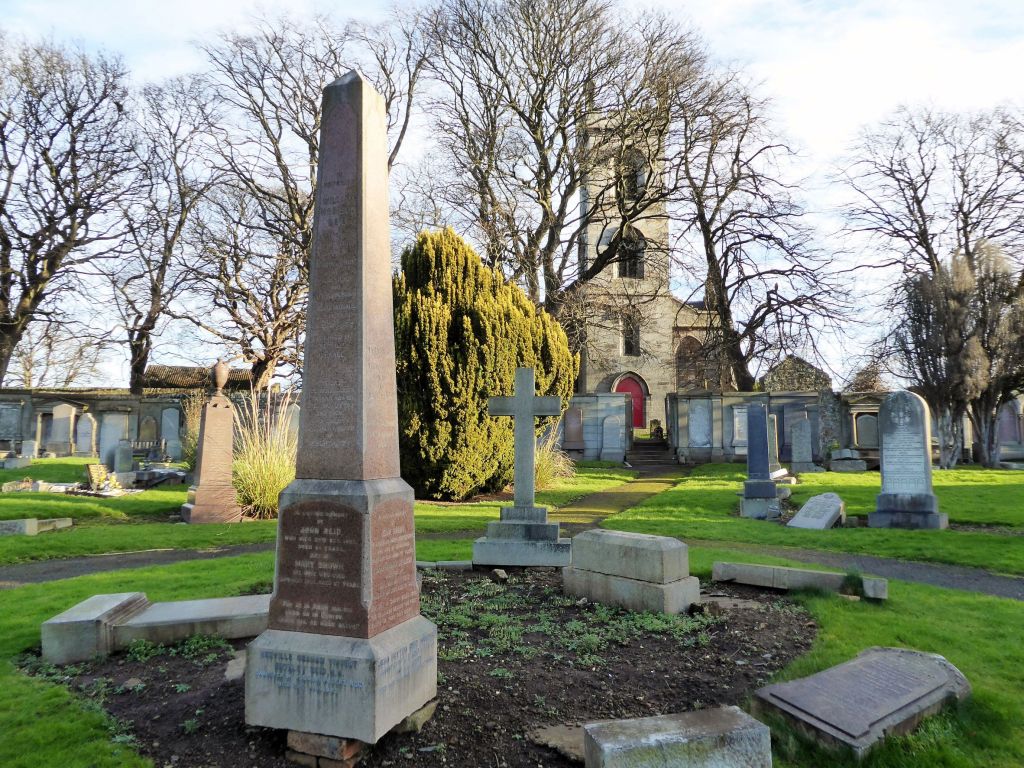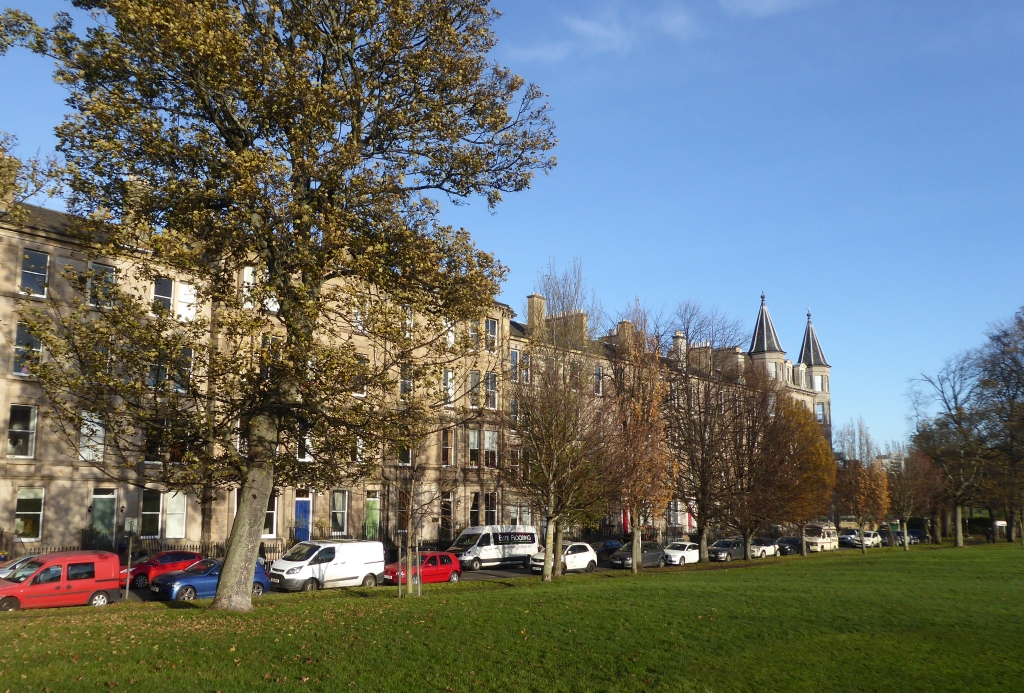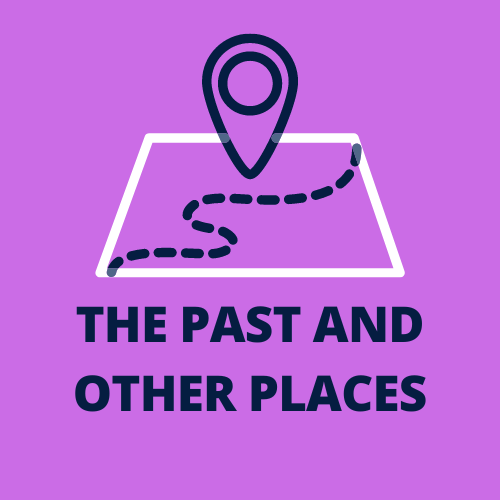Something always catches the eye when you take a shortcut through a cemetery. Liberton cemetery in Edinburgh sits next to the church and its graveyard and has a commanding view across the city, taking in a stretch from the hills in the west to the sea in the east, and of course Arthur’s Seat. The ranks of monuments and their brief inscriptions hint at past lives.

When Neil Gregory of Historic Environment Scotland (HES) tweeted that they would like to know more about architect Jean Payton Reid, a quick search on Find My Past revealed that Jean, her parents and grandparents were all commemorated on a Reid family monument in Liberton cemetery (as recorded by the Scottish Genealogy Society). A visit revealed the inscription is on an eye-catching pink granite Egyptian-style obelisk.

This obelisk records Jean Payton Reid, architect, died 14 Feb 1997. Her father was the painter Robert Payton Reid ARSA (1858-1945) and her mother Emily Esther Smith (1876-1961). There are, however, few details about Jean Payton Reid in the Dictionary of Scottish Architects.
Jean the architect and planner
Jean studied architecture at Edinburgh College of Art (ECA) and was awarded a Rowand Anderson prize of £20 in 1940.[1] On election as an associate fellow of RIBA her full name was published in The Scotsman as Mary Louisa Jean Payton Reid – an important clue for finding official records.[2]
Niamh Crimmins of HES wrote a blog about Jean in 2018 and stated Jean gained practical experience working in the architectural practice of Tarbolton & Ochterlony (1937-8) while a student.[3] HES holds Jean Payton Reid’s student portfolio of architectural drawings and Niamh Crimmins catalogued them in 2017. Several drawings are reproduced in the blog.
“We know she studied at the School of Architecture, Edinburgh College of Art (ECA) from 1934-1940, but we know very little about her after that time. … The collection appealed to me because it’s a relatively rare example of the work of a female architect in a male-dominated field. It is quite varied, with designs for private houses, a music school, a holiday camp for children and even a dam!” Niamh Crimmins 2018
One thing that Niamh Crimmins did establish is that Jean was a member of the Royal Town Planning Institute – a membership that didn’t lapse until 1974 when Jean would have been in her late fifties. Was she a town planner?
Plan Scotland Now
The Art for the People exhibition toured Scotland in 1940-2 and had a section on planning by Rona Inch Morrison assisted by Jean Payton Reid (ECA Town & Country Planning dept.).[4] ‘Plan Scotland Now‘ included large-scale photographs to show ‘haphazard building’ in Edinburgh and more positive achievements of Scottish architects.
“It recognises that there are certain features which must be preserved, but photographs of bomb damage indicate the opportunity for immediate planning which has arisen.” The Scotsman Oct 3 1941
Hubert Wellington (1879-1967), ECA principal 1932-42, had encouraged Rona Inch Morrison, a member of the staff of the School of Architecture, to undertake the exhibition and Jean received appreciation for the valuable help she had given.[5] According to the columnist, it had taken the women months and many days of holidays to make the display a reality. The 1942 article in the Edinburgh Evening News also notes Jean Payton Reid was employed with the Scottish Department of Health as a town planner.
‘A woman journalist’ reported on the exhibition in some detail in October 1941 in The Scotsman, noting that after visitors had made a tour of the room they were invited to write their own suggestions in the book provided.
“The model city… is built like a wheel. The administrative, shopping and amusement block is in the centre. There is a green belt at a certain radius from it, never in all time to be built upon. Roads go out like spokes, with a residential area between the green belt and another green belt beyond.” The Scotsman 8 Oct 1941
Sometime after October 1942, Jean Payton Reid moved from the Board of Health to become assistant planning officer with Dumfries County Council. Subsequently, in January 1945, Miss Reid was promoted by Dumfries C.C. and appointed Scotland’s first woman planning officer.[6] This occasioned an interview by Louise Petrie for a women’s column in the Daily Record newspaper.
“When I visited her, she frankly admitted she had no radical changes in mind. She will tackle things as they crop up. Ideas of her predecessor appeal to her and she is working on these meantime. … I don’t think Dumfries County Council will regret entrusting this important work to a young lady. Miss Reid has a definite grip on things.” Daily Record 29 Jan 1945
Dumfries County Council had ambitious plans to transform the villages of Kirkconnel, where miners’ housing badly needed upgrading, Gretna, where there were still World War One Army huts being used as homes, and to consolidate Holywood and Closeburn. It is clear from the article Miss Reid preferred to concentrate on the issues and challenges the role presented than her person.
The trail goes cold at this point. Did Miss Reid continue to work as a planner? Her continuing membership of the Royal Town Planning Institute suggests she did and the lack of evidence only reflects a lack of easy digital access to source material between 1950 and 1998.
After her death in 1997, Christies, Glasgow, sold 80 lots being the property of the late Miss M.J.L.P. Reid, by order of the beneficiaries Robert Payton Reid ARSA (1859-1945).[7] They included her portfolio of student work which eventually found its way to HES.[8]
“A folio containing a large quantity of architectural drawings of public and residential buildings executed between 1937-1940, including a National Theatre, a Funicular Railway and a House in the Highlands; a small selection of life Class female drawings; and interior colour scheme plans.” Christies Lot 72 25 Aug 1997
Jean’s personal life
Jean was born in Islington on 4 Jan 1917. The Reids are in the June 1921 census at St Ives, Huntingdonshire, although they are mentioned in The Scotsman as attending a reception in Edinburgh in April 1921.[9] It is not clear when they moved to Scotland permanently, but in 1935 the Valuation Roll shows Robert Payton Reid was listed as proprietor and occupier of a tenement flat at 10 Glengyle Terrace, overlooking Bruntsfield links.[10] Around this time it is likely Jean became a student at ECA.

Although Jean grew up an only child, she had a number of Reid relations in Scotland. In 1932 her cousin Captain J Payton Reid married Anne Coventry Service; Jean, age 15, was a bridesmaid along with another cousin Merville Reid. A detailed report of this society wedding notes the bridesmaids wore delphinium blue chiffon.[11]
Jean’s engagement to Robert Mitchell was announced on 22 July 1941 in The Scotsman, but it does not appear that the marriage took place.[12] Robert, known as Roy, was the youngest son of the late Mr and Mrs W.G. Mitchell of Londonderry. Jean Payton Reid’s address is given as 24 Dick Place, Edinburgh. This was and is an upmarket area of sandstone villas with gardens in the Grange.
In January 1945, when Jean was 28 and had just taken up the role of planning officer at Dumfries C.C., her father died at the family home at 24 Dick Place, Edinburgh. He was described as a retired artist (painter), age 86, and Jean Payton Reid was the informant.[13]
Jean’s mother was around 17 years younger than her father and Emily Payton Reid, as she styled herself, lived until 1961. Emily Esther Reid (m.s. Smith) was 84 when she died and her address was 10 Palmerston Road – another sandstone villa just off Grange Road; again the informant was Jean P Reid, now in her mid-40s.[14]
As the memorial in Liberton cemetery records, Jean Payton Reid died on February 14 1997. Her death registration records her as Mary Louisa Jean Reid aged of 80 who died in Edinburgh.[15]
Jean’s parents
Jean’s parents Robert P Reid and Emily E Smith were married in 1916 in Hackney, London, when he was around 57 and his new bride 40.[16] It is assumed Robert and Emily lived in London, perhaps with Emily’s family, as Jean was born in Islington, in 1917 and given the name Mary Louisa Jean Payton Reid.[17] It does not appear they had further children. This couple seem to have been known in social circles as the Payton Reids.[18]
Jean’s father Robert Payton Reid was born in 1858 in Liberton to John Reid and Mary Brown. The 1871 census, when Robert was a scholar aged 12, shows the Reid family lived at Powburn House. The couple had two sons and three daughters living with them, along with an older relation and a servant. Robert’s father John Reid was a leather dresser employing 31 men, 11 boys and one woman.[19] Powburn House was just off Mayfield Road near Mentone Terrace in Newington, next to a works.[20]
By the 1881 census, the Reid family were at Tornaveen House, Gillsland Road; father John, 60, continued to run a leather dressing business. Robert, 22, was described as an artist (painter) and his older brother John, 24, as a graduate in Arts.[21] Tornaveen House is a substantial sandstone villa, with an impressive tower, designed by Robert Raeburn c.1875 (image).[22]
Robert’s 1945 obituary in The Scotsman reveals he was educated at George Watson’s College and studied drawing at the school of the board of manufacturers and the Trustee’s Academy (forerunner of Edinburgh College of Art). He was awarded medals there and subsequently travelled in Europe and exhibited works at the Royal Scottish Academy (RSA). In 1896 he was elected an Associate of the RSA.[23] The 1901 census records that Robert, 42, an artist, was still single and living with his widowed mother and his older sister at Hill House in Inverkeithing, Fife.[24] At some point in his travels, perhaps rather late in life, he met his wife to be – probably in London.
Jean’s mother, Emily Esther Smith, 24, was living at the family home 100 Cazenove Road, Hackney, London in 1901.[25] Sidney Smith, 64, her father, was a jeweller, furnisher and pawnbroker (employer) and his wife Ellen Sophia was 68. There were three adult children living at home, a cook and two female servants. By 1911, they had all moved to 133 Highbury New Park in Islington, another area of Victorian villas, and there was now a fourth servant – a sick nurse.[26] That they were affluent is further underlined by the fact they lived in a house with 15 rooms. The 1911 census makes clear Sidney and Ellen had only been married 13 years, so it is unlikely Ellen was Emily’s mother. The 1881 census, when Emily was four and the family lived at Newington Green, gives Sidney’s wife’s name as Louisa and lists eight children.[27]
So, the evidence suggests Jean Payton Reid’s two first names, the ones she didn’t use, were after her grandmothers Mary and Louisa. By being known as Jean, neither grandmother was favoured over the other.
The stories of lost women
Professor Suzannah Lipscomb has posed the question “How can we recover the lost lives of women?”. She argues the lives of those who women who appear fleetingly are as meaningful as those who left behind a wealth of documentation. We know archivists have been selective about what has been kept. Historians select further from that. We might not be able to fully recover women’s lives from what is available to us now, but we do need to seek out and tell the stories of lost women when we come across them.[28]
References
- The Scotsman May 11 1940.
- The Scotsman Oct 19 1940.
- Niamh Crimmins (7 March 2018) The Mystery of Jean Payton-Reid https://blog.historicenvironment.scot/2018/03/mystery-jean-payton-reid/
- The Scotsman May 12 1942.
- Edinburgh Evening News May 13 1942.
- Daily Record Jan 29 1945.
- Christie’s, Glasgow (1997) Robert Payton Reid https://www.christies.com/lot/lot-378833
- Student portfolio of Jean Payton Reid, HES https://bit.ly/3GdQyDi
- The Scotsman April 25 1921.
- Valuation Roll 1935 10 Glengyle Terrace, Edinburgh (VR010000742) [Scotland’s People].
- The Berwickshire News Sep 13 1932.
- The Scotsman July 22 1941.
- Deaths 17 January 1945, Newington, Edinburgh (685/6 57) [Scotland’s People].
- Deaths 11 May 1961, Morningside, Edinburgh (685/7 481) [Scotland’s People].
- Deaths 1997, Edinburgh (730/197) [Scotland’s People index].
- Marriages 1916, Hackney, London Qu.1 Vol 1B, p941 [FMP transcript].
- Births 1917, Islington, London Qu.1, vol 1B, page 303 [FMP transcript].
- The Scotsman April 25 1921.
- 1871 census Newington, Edinburgh schedule 66 [FMP transcript].
- NLS maps 25-inch Edinburgh 1892-1914 https://maps.nls.uk/transcriptions/edinburgh/viewer/
- 1881 census St George, Edinburgh schedule 100 [FMP transcript].
- Tornaveen House HES http://portal.historicenvironment.scot/designation/LB27094
- The Scotsman Jan 18 1945.
- 1901 census Inverkeithing, Fife RG13, schedule 105 [FMP transcript].
- 1901 census North Hackney (RG13/213/35/62/323) [FMP].
- 1911 census Highbury, Islington (RG14/979/219/33) [FMP].
- 1881 census Highbury, Finsbury (RG11/253/6/5/21) [FMP].
- Suzannah Lipscomb (2021) ‘How can we recover the lost lives of women’, pp178-196 in Helen Carr and Suzannah Lipscomb (eds.), What is History, Now?: How the past and present speak to each other. London: Weidenfeld & Nicolson. https://www.worldcat.org/title/1229089448
A note on digital newspapers as a source
Most of the newspapers accessed were obtained from the British Newspaper Archive (BNA). Digitised newspapers can only help us far as they have been scanned and made available (usually only one edition). The quality of the indexing, based on character recognition, varies. Historical copies of The Scotsman are available for the period 1817-1950 from the digital archive on ProQuest Historical Newspapers. More recent articles published in The Scotsman can be obtained from 1998 to the present via NewsBank.

First published 14th Jan 2023
Except where otherwise stated, The Past and Other Places by JKW (Kay Williams) is licensed under a Creative Commons Attribution-NonCommercial-ShareAlike 4.0 International License
